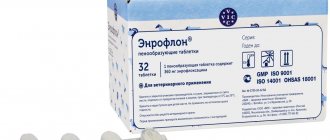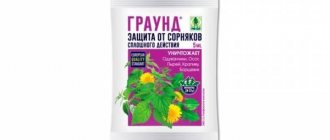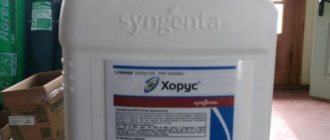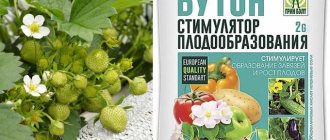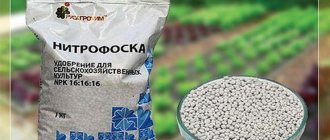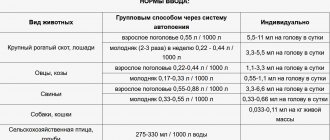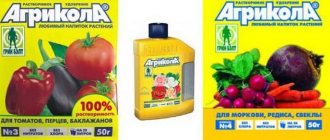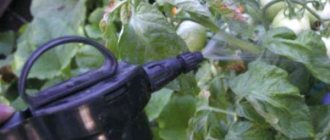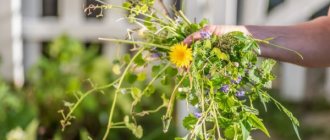Home / Preparations and fertilizers
Back
Published: 10/21/2020
Reading time: 8 min
3
One treatment - and no weeds! A gardener's dream. The name of this miracle is the herbicide Roundup. But just as there is no silver lining, so it is the other way around. You always have to pay, and it's not about money. Roundup (pictured) is not that expensive given its effectiveness: the universal poison will destroy weeds and even shrubs and trees that have no place on the site.
Why is the World Health Organization (the same one that works under the UN) seeking to completely ban the drug, and European countries, one after another, are removing Roundup from the list of permitted herbicides? If the problem is identified at this level, then it is unlikely that the instructions for use are simply not followed. The advantages and dangers of a product that has been saving farm fields and private lands from ineradicable weeds for half a century is the topic of the article.
- 1 Death to weeds or humanity?
- 2 Safety regulations
- 3 If you're scared, but really need it
- 4 Lifehack for security
- 5 Preparation and use
- 6 Analogs
- 7 Reviews
Death to the weeds or to humanity?
It would seem that summer residents of all Rus' should thank the developers (later Bayer) for easing the hard work of peasants. Just weeding away the malicious weeds takes up to half of all the time and effort devoted in the struggle for the harvest. Sprayed - with a slight movement he killed the ubiquitous hogweed, the hated sow thistle, the root shoots of fruit or ornamental bushes and trees. But will the fruits be as safe as we would like?
The source contains a brief scandalous history of the company and the essence of the claims against the drug.
Roundup, registered in the Russian Federation until June 17, 2022, is already about. It is surprising that such devastating harm can be caused by a drug whose description includes hazard class 3. Any summer resident knows that a product with such a mark is low-toxic. This is even lower than that of Bordeaux mixture.
But the WHO has serious concerns about Roundup. The organization believes that the widespread use of the product is the reason for the increase not only in oncology, but also in cases of autism. Therefore, the goal is to quickly ban the use of the herbicide.
Roundup has a harmful effect on the soil. Complete breakdown of glyphosate chelates occurs within 4 years. The same amount of time will be needed to reclaim the land. Each time the substance gets into the soil, it causes thinning of the fertile soil layer: one treatment - minus a couple of centimeters.
Gardeners who dare to use Roundup are recommended:
- cultivate the area for fruit and vegetable crops in the fall;
- Apply the weed killer only once per season.
Chemicals are dangerous and effective
The main characteristics that make up the chemical description of Roundup:
- a product from the group of organophosphorus compounds;
- an active ingredient that has the ability to destroy any weed is glyphosate;
- concentration of isopropylamine salt (a more accurate name for the form of DV in Roundup) - 360 g/l;
- form - aqueous solution (marked as VR on the label and in the instructions);
- by nature it is a continuous action herbicide, that is, non-selective - any plant that is exposed to Roundup is doomed to death;
- according to the method of penetration - contact and systemic (through the stomata of the above-ground green parts it enters the plant organism and spreads with juices throughout all tissues, right down to the roots).
Registration number, where you can also find information about the drug and contacts of the manufacturer: 2369-12-108(110)-359-0-0-3-1.
It must be remembered that the drug should absolutely not be combined or mixed with pesticides and other agrochemical products, including fertilizers (except for the life hack described below). If fertilizing of cultivated plants or protection from infections or pests is planned in the garden, then these procedures are carried out earlier or postponed for a period of at least 21 days from the day when working with Roundup.
Mechanism of action of the drug
The effect of Roundup does not begin immediately after applying the drug to the leaves of the plant. It should take from 6 to 12 hours before the weed destruction mechanism starts working. Rain during this time reduces the effectiveness of the herbicide; it washes away most of the poison from the leaves.
Important! Before using the drug, check the weather forecast - dryness and heat are optimal for 100% destruction of weeds.
The toxic substance that is part of Roundup is absorbed into the plant, its distribution throughout all parts of the weed occurs gradually, lasting 5-10 days. Areas of its distribution:
- roots;
- tubers;
- stolons;
- actively growing shoots.
Visible signs of Roundup's action on the weed appear after 7-10 days. The shoots begin to wither, turn yellow, and turn red. Complete death of the weed from the herbicide occurs no earlier than after 20 days. The manufacturer stated the action interval of the poison is 20-30 days. During this time, all above-ground (shoots, leaves, stems) and underground parts of the weed completely die.
Safety regulations
Since Roundup is not yet prohibited for personal gardens, it is important to remember safety measures before and after using a poisonous concentrate, no matter whether liquid or powder:
- Even start preparing the solution after putting on a full set of PPE, which protects against droplets getting on the skin (causes cancer), hair (poison is well absorbed into it), eyes and respiratory organs. Rarely a summer resident will boast of professional clothing for working with chemicals, so a long raincoat, rubber gloves, a hat or scarf, and canned glasses (tight-fitting) will do.
- After processing, all vestments are first soaked in water with dissolved soda (50 g), then washed, washed with powder or laundry soap.
- Processing should not be interrupted for a snack or a smoke break, and combining it with them is even more strictly prohibited.
- The best time is a calm, warm evening. The DV loses power in the light, so it is optimal to work at dusk, when rain is not expected.
- Store canisters and vials at temperatures within the range: -15 °C…+45 °C. Thawed liquid remains effective.
- Empty containers are disposed of separately - burial is required at sites remote from populated areas and animal grazing areas. It is unacceptable for liquid residues or empty containers to enter water bodies.
Accidental contact with Roundup is extremely dangerous. Before receiving first medical aid, be sure to do the following:
- wash the affected area with running water and soap;
- if inhaled or swallowed - a set of measures consisting of taking activated carbon with warm water (0.5 l), followed by forced vomiting. Repeat 2-3 times.
There are no specific remedies for Roundup poisoning. But medical intervention is necessary. Doctors should carry out standard treatment, as for ordinary poisoning.
If it's scary, but really necessary
Since Roundup really quickly and reliably copes with unwanted vegetation on the site, its use is justified in the following cases:
- Clearing heavily overgrown areas or virgin lands from weeds, trees, and bushes. Having carried out the treatment in the fall, in the spring the gardener will clear the area of plant residues and begin to develop the land for planting garden crops.
- Destruction of weeds that cannot be eradicated by hand weeding on land intended for ornamental plants. Work begins at the beginning of the season or in the fall.
- Planned sowing a year after treatment, while the land, freed from thickets, rests fallow. Option for planting grain and vegetable crops. Over the course of a year, the poisons will partially decompose and in the half-life stage will not be so dangerous.
- Cleaning areas along the fence or behind it, along the perimeter of the site.
- Treating areas for sowing lawns where fruits and vegetables will definitely not grow.
Experts recommend using not the basic Roundup, but its equivalent, Max, which is valid in the Russian Federation until March 2024.
A product with the same degree of danger and effectiveness. But Roundup Max has a number of advantages, the main one being speed. Comparative characteristics are given in the table:
| Parameter | "Roundup" | "Roundup Max" |
| Duration of complete absorption (in the absence of precipitation) | From 6 hours | 1 hour |
| Time required for first manual harvesting | 7 days | 1 day |
| Temperature range for processing | From +15 °C to + 25 °C | From +2 °C to +30 °C |
| Optimal air humidity (required minimum) | 70% | 50% |
| Composting or plowing tops of dead weeds | No, only burning | Yes, in a week |
In addition to the listed criteria, Roundup Max’s ability to destroy rhizomatous and herbaceous perennials the first time reaches 100%, while the opponent’s ability does not exceed 70%.
Both drugs show maximum effectiveness on young plants that are not yet ready to flower:
- weeds - no later than the 4th leaf;
- burdock, thistle, thistle - until the flower arrow comes out.
Regrowth is the result of newly sprouted weed seeds.
When to use herbicides
If there are a lot of weeds in the garden or vegetable garden that reproduce by rhizomes, it makes sense to use herbicides. Simple mechanical weeding using devices (hoes, flat cutters, root removers) destroys only the above-ground part of the plant.
New shoots will come from the piece of rhizome remaining in the ground. To keep the area clean, you have to constantly weed. You will have to pick up a hoe often, given that weeds are very tenacious, aggressive, and quickly recover.
Herbicides have a destructive effect on the root, which allows you to destroy an unnecessary plant and clear beds, overgrown areas of the garden, and fields from spreading weeds. The effect of using a herbicide far exceeds the results of manual weeding.
Lifehack for security
Experts recommend that private owners use a special roundup breeding scheme. This is not about human safety (observance of the described precautions is not canceled), but about reducing the risk to the soil. The method will require efficiency. The solution will lose its effectiveness within an hour after preparation, but the decomposition of glyphosate will not have such a detrimental effect on the health of fertile soil, and the result of the treatment will even exceed expectations.
The essence of the method is that the drug must not be diluted in ordinary water. The toxic liquid is added to a 5% urea solution. At the same time, to spray one hundred square meters of land, the same 5 liters will be required as in conventional schemes (see below), and the dosage of the drug is significantly reduced. Instead of the recommended 40 to 120 ml for clean water (for various weeds), only 18 ml is required. If powder is used, then the proportion is 0.5 kg per bucket. That is, in terms of consumption, this option for killing weeds is even more profitable.
The frequency of such processing is no more than 1 time per year.
Preparation and use
Since Roundup is used to get rid of weeds at an early stage of their development, spring treatment is suggested. But on a number of vegetative crops it is permissible to act only after harvesting.
How to divorce correctly:
- calculate the required amount of the finished solution (the working fluid is not suitable for storage - there is no point in diluting the product with a reserve);
- pour half the volume of water or a 5% urea solution into the sprayer;
- pour in the concentrate in the required ratio (how much Roundup is required is indicated in the table below);
- add water to full volume.
The norm for any planting is 5 liters of working solution. The dose per 10 liters depends on whether the weeds are perennial or annual plants. General recommendations are in the table.
| Landings | Object of destruction | Dose (ml) | Peculiarities |
| Garden: fruit trees and vineyard | Annuals | 80 | Spot application in early spring |
| Perennials | 100 | ||
| Vegetables, strawberries, melons | Annuals | 80 | Only in the fall - after harvesting the fruits |
| Perennials | 120 | ||
| Potato | Any | 40-60 | Only in the fall, after digging up the tubers |
| Areas where cultivated plants will not be planted (paths, along fences) | Any | 80-120 | Spring |
About the correct use of toxic chemicals - in the video.
Roundup: purpose, features
The drug belongs to the category of non-selective herbicides. Its purpose is the destruction of perennial and annual weeds. At the same time, the poison destroys not only weeds (dicots and cereals), its destructive effect extends to any cultivated plant.
Important! Do not allow the herbicide solution to come into contact with the leaves of vegetables, flowers, or other useful plants; they will die under the influence of Roundup.
Analogs
Since formally the validity period of Roundup expires in mid-2022, and in fact the desiccant, as well as the version of Roundup Extra (from the same manufacturer from Belgium) are already prohibited, summer residents are left with Max, the advantages of which are noted in the article. In country stores, drugs under this name are more often found.
What else can be used to replace a product that contains glyphosate, which is dangerous for the human body and the soil:
| Name | Manufacturer | Registration period |
| Rubit "Santi" | LLC TPK "ROSTI" | 11.02.2025 |
| "Alpha Ataman" | "Alfakhimgroup" | 02.06.2022 |
| "Aristocrat" | "Listerra" | 11.02.2023 |
| "Helios" | 04.11.2021 | |
| "Glibel" | Belin LLC | 17.12.2024 |
| "Glitter" | "GRANUM" | 16.06.2021 |
| "Glyphosance" | "Agro-Alliance" | 19.11.2022 |
| "Judo" | "Agrotechinvest" | 11.12.2026 |
| "Napalm" | "RosAgroKhim" | 04.10.2022 |
| "Octopus" | "Shchelkovo Agrokhim" | 20.08.2022 |
| "Tornado® 500" | "August" | 11.03.2022 |
| "Total" | "AgroExpert Group" | 06.05.2021 |
| "Fighter" | "Amuragrokhim" | 13.12.2022 |
Most weed killers contain glyphosate at the same concentration as Belgian Roundup. It is worth paying attention to “Tornado 500”: the figure indicates an increased dose of isopropylamine salt. Among the proposed options, many are not higher than class 3 danger for humans and bees. Expiration dates and features of use are in the instructions for each drug.
Online stores, along with the above drugs, sell Rubit “Santi”, without mentioning that in the current herbicide reference books it is listed as “not valid”, that is, the product of TPK “ROSTI” LLC is prohibited for use.
Others, once popular, but already removed from the permitted list:
- "Hurricane". Registration ended in 2021, and glyphosate was in the form of potassium salt;
- "Zeus". The last year of work with the drug is 2021.
Considering the real danger of the means that have to be used to protect the site, the relevance of drugs for which “Roundup” is already a common popular name should be studied. The cost of liquidators to remove weeds does not always justify the price paid due to health reasons.
Reviews
Novikova Ksenia, Saratov
For years I envied my neighbor with her clean, well-kept garden. But I know that she achieves results using Roundup, which has a lot of negative reviews, despite its effectiveness. Today I have finally decided not to get involved with strong drugs because of this situation. A neighbor complained that she had destroyed her greenhouse crops—tomatoes and cucumbers. I accidentally mixed up the sprayers: I used the one I poured Roundup into in the spring to treat pests. Cultivated plants died.
Pletnev Igor, Novorossiysk
I've always been against glyphosate. Hectares of land were killed while crops were poisoned with roundups. It’s better to pull out the weeds by hand and use folk remedies to get rid of the growth, fortunately there are many recipes. Yes, it's labor intensive. But it’s not scary to feed your grandchildren strawberries and apples.
Useful tips for gardeners
Following a few simple rules will help you avoid the unpleasant consequences of using Roundup:
- The drug retains its effect for 7 days, but only if stored in a closed container.
- There is no need to weed weeds before spraying.
- After treatment, it is not recommended to touch the plants for a week.
- Neighboring vegetable crops must be protected with film or other dense material; in case of accidental contact, it must be spilled with a large amount of water.
- Do not store the container in which the drug was diluted.
- After spraying, be sure to thoroughly wash your hands and those parts of the body that may have come into contact with the herbicide with soap.
- If Roundup poisoning occurs, you should immediately seek help from a doctor.
Reviews about the drug are positive. It ranks first among herbicides, which allows you to quickly get rid of unwanted weeds on the site.
